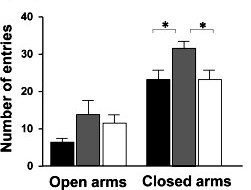Early (post weaning) isolation in rodents is associated with inceased anxiety and depressive like phenotypes, locomotor dysregulation in novel environments and increased stress vulnerability During the implementation of this model, immediately after weaning, animals will be housed individualy for 6 weeks in cages. Mice that will be group housed in cages of the same size will serve as controls. This procedure has been used extensively in both mice and rats.
Reproduced with permission from Elsevier
(http://www.sciencedirect.com/science/journal/01664328)
Ishikawa et al 2014: Effects of early social isolation (gray bars) and enriched environment (white bars-running wheel) on anxious like phenotypes demonstrated in adult rats undergoing the elevated plus maze test. Rats exposed to social isolation demonstrated more closed arms entries attesting to greater anxiety levels.
References:
Dong E, Matsumoto K, Uzunova V, Sugaya I, Takahata H, Nomura H, Watanabe H, Costa E, Guidotti A (2001) Brain 5alpha-dihydroprogesterone and allopregnanolone synthesis in a mouse model of protracted social isolation. Proc Natl Acad Sci U S A 98(5):2849-2854
Ishikawa J, Ogawa Y, Owada Y, Ishikawa A (2014) Hyperlocomotor activity and stress vulnerability during adulthood induced by social isolation after early weaning are prevented by voluntary running exercise before normal weaning period. Behav Brain Res 264C:197-206

